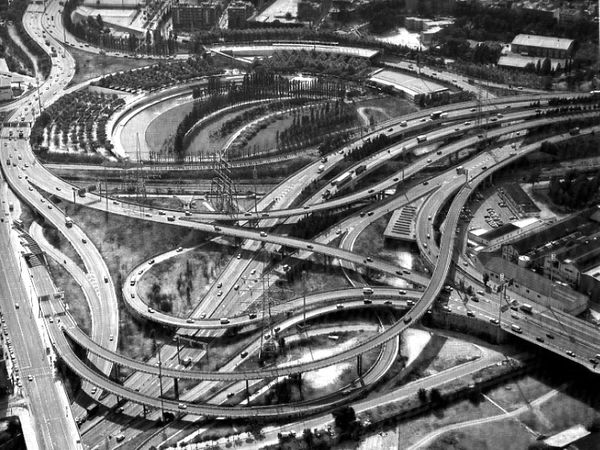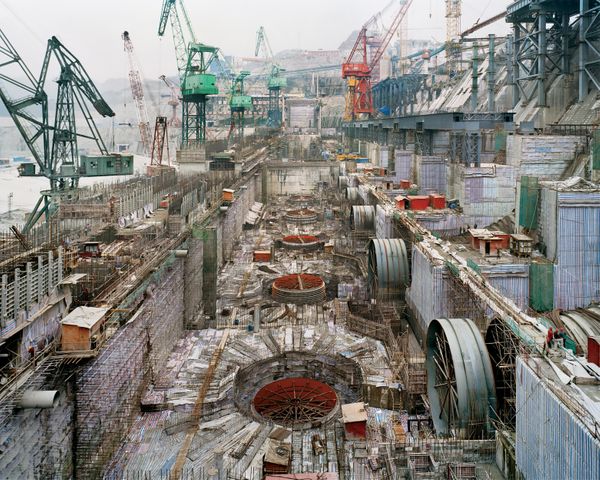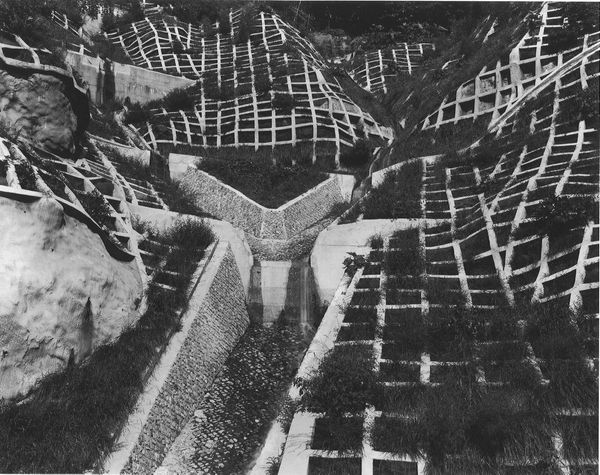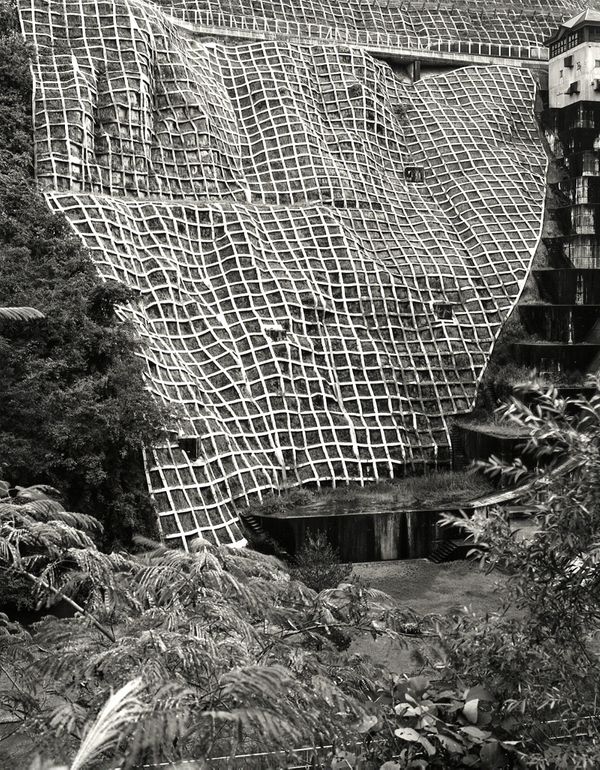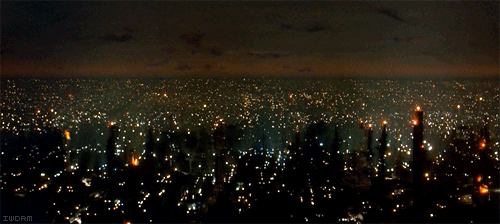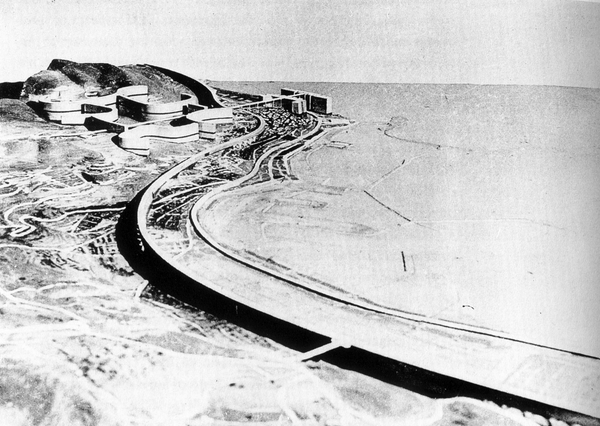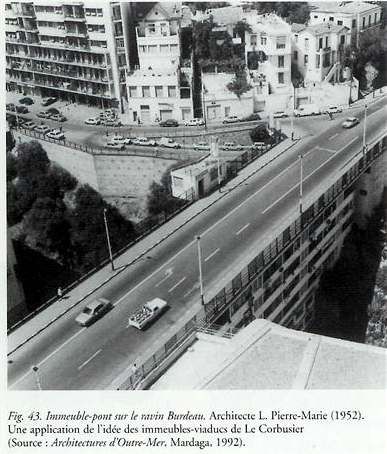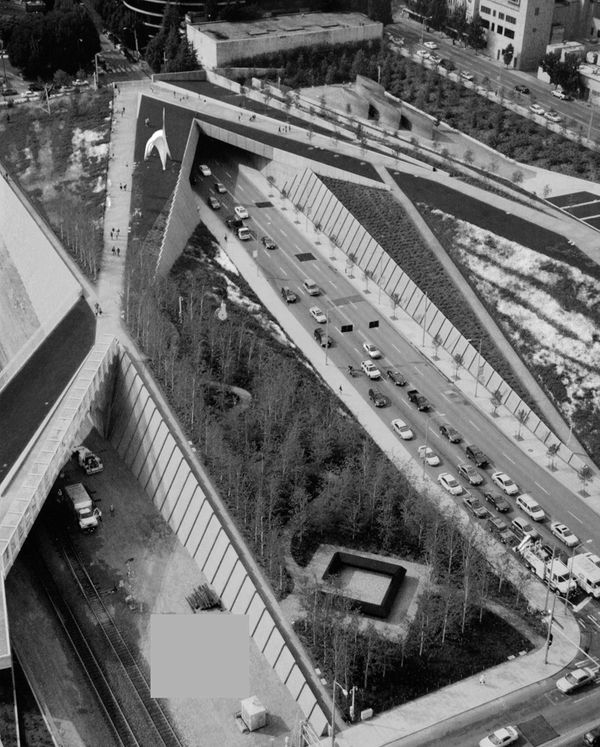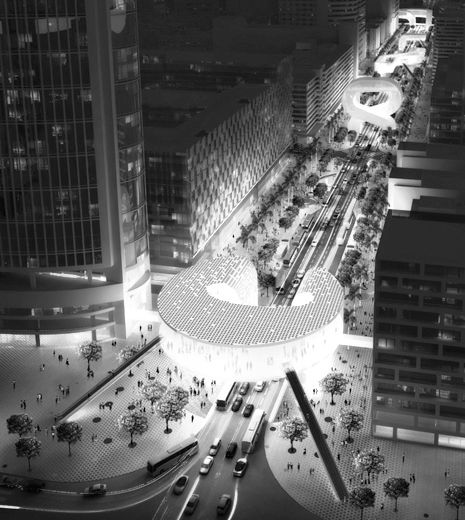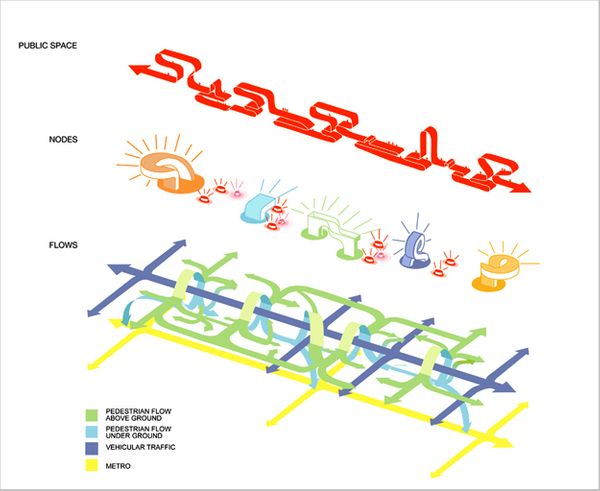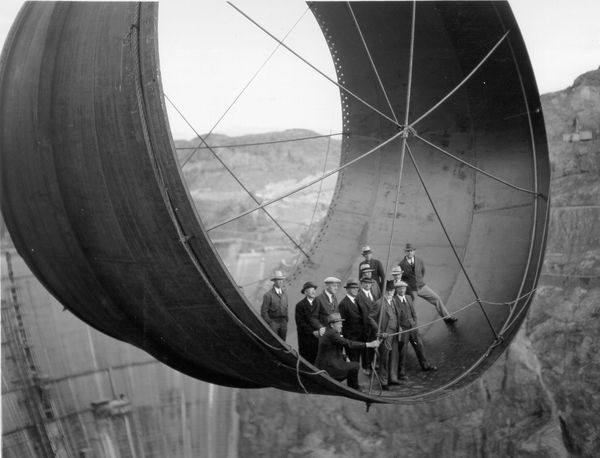
"Polyvalent Infrastructures" Published in 100th Annual Proceedings of the ACSA
I FROM MASSIVE TO NIMBLE
"The past is big monolithic buildings. The future looks more like a substation." Tom Vanderbilt, "Data Center Overload"[i]
It used to be, in the days prior to Google Earth, that the phrase “visible from space” was reserved for only the most massive manmade infrastructural works: the Great Wall of China, the Nazca Lines, the lights of American conurbations seen at night. But we have entered an era in which virtually everything can be seen from space, so to speak. And not only is everything orthographically visible, but these objects can now be inscribed with hypertextual data such that a single image can actually provide a multidimensional array of information regarding not only spatialities but statistics as well. The result is that many of our formerly unvisualizable infrastructures have taken on a new legibility. The Situationist psychogeography of cities understood as a series of discontinuous jump cuts—portrayed as a fragmented and elided map-collage in the famous Naked City image by Guy Debord—has given way to the city as instantaneous and literal projection: Google Earth as cognitive map.[ii] No longer collagists of space, we now zoom from the scale of a city to the scale of the brick in a matter of seconds. Thus, a freeway loop tens of miles in diameter and a single-family residence possess a kind of equivalence within the logics of geographical mapping. Granularity of detail is the same, seen in pixels.
This new regime of visualization has paralleled the broadening of our definition of infrastructure, from once imagining it as the simple housing for a technical program to now viewing it as a site of logistical operation that enables events to occur. We now regard infrastructure as an urban nervous system sending signals back and forth, organizing various types of flow. In a world of remote sensing and digital information, the complexities of infrastructure—as well as its impacts on land, habitation, and urbanism—are easier than ever to understand. Landscape architects such as James Corner and Alan Berger have in recent years used large scale mapping exercises to identify infrastructure’s specific impacts on its surroundings.[iii] The result is that the profession of landscape architecture regards the built environment as an ecological, polyvalent meshwork of systems: cultivated landscape, infrastructure, buildings and wilderness, all functioning symbiotically. Even waste landscapes, the byproduct of infrastructure and development which Alan Berger terms drosscape, are productively integrated into landscape practice. Architects could learn a considerable amount from their collaborators in landscape architecture about the opportunities inherent in infrastructure for creating polyvalent urban space.
The infrastructures of the modern era tended toward massiveness, a period when our spatialization of the world underwent dramatic transformations, from the advent of the microscope and the x-ray (zooming us in), to the ability to map territories by airplane and, later, by satellite (zooming us out).[iv] New modes of visualization, coupled with building technologies such as steel and concrete and technologies of energy transfer, allowed our infrastructural imagination to shift to new dimensions. Thus, when Franklin Delano Roosevelt visited the American West and the Columbia River Gorge in 1933 with the ambition of building not one but three large dams, these dams were conceived on an unprecedented scale, diverting river systems and changing the landscape and flow of energy in the region forever.[v] Roosevelt’s Public Works Administration (PWA) was also responsible for the Triborough Bridge and Lincoln Tunnel in New York, the Overseas Highway in Florida, the electrification of the Pennsylvania Railroad, and 11,000 new roads and 7,000 new schools, among many other projects.[vi]
Even if their stylistic programs were divergent, this kind of ambition was in keeping with Modernist utopian thinking, which attempted to master-plan the city’s dense interplay of networks, movements, and events. Modernism’s primary urban manifestoes, such as the Athens Charter of 1943, proposed replacing the organic texture of cities with massive, singular systems that corralled and purified space. The city was regarded fundamentally as an axial, Cartesian, rationalizable structure. Even after skepticism about Modernist urban planning began to creep in (in the wake of Pruitt-Igoe, American urban renewal, and other fallout), architects were unafraid to imagine at vast scales.[vii] Well into the 1960s, architects were still issuing their systems-intensive, utopian programs to the world, now in a decidedly tongue-in-cheek vein: Yona Friedman’s hovering megastructural carpet, Constant’s New Babylon with its sectors and layers, Archigram’s Instant City.
But between the late 1960s and the present, a transition was occurring that seemed to refocus architecture away from infrastructural thinking. This was partly due to a shifting disciplinary focus within the profession of architecture itself, away from pragmatics and toward theory, as Ignasi de Solá-Morales, Stan Allen and others have discussed.[viii] But it also resulted from the rise of new technocracies of planning, which moved engineers and other specialists into heightened roles of authority in the design and construction of infrastructure. Chris Reed writes relative to landscape architects, and the same holds true for architects, that “newly anointed technocrats assumed an unparalleled social status, one of almost unassailable legitimacy, while landscape architects retreated to the cultural margins…Landscape practices eventually congealed into one of two molds: as decorative art…or as science-based planning methodology, often co-opted for purely economic development purposes.”[ix] Arguments regarding infrastructure were thus ceded to engineers, urban planners, and bureaucrats for thirty years. This disengagement with the pragmatic objects and systems of the city has had consequences that architects may not have foreseen. Vast networks were being built with which we would later be forced to contend, or succumb.[x]
In the mid-1990s, Rem Koolhaas published an essay that has since been widely quoted, entitled Bigness, or the Problem of Large. It became a kind of provocation for architects to once again think at a massive scale, after the turning-inward of the 1970s and 1980s. In the essay, Koolhaas outlines the exceptional difficulty and uncontrollability of designing large projects:
“Bigness is where architecture becomes both most and least architectural: most because of the enormity of the object; least through the loss of autonomy—it becomes instrument of other forces…. It implies a web of umbilical cords to other disciplines whose performance is as critical as the architect's…Beyond signature, Bigness means surrender to technologies; to engineers, contractors, manufacturers; to politics; to others. It promises architecture a kind of post-heroic status—a realignment with neutrality.”[xi]
Almost more than bigness, Koolhaas seems to be addressing the need for architects to re-engage the complexity of the world, with a new understanding of our own placement in an array of disciplines, many of which deal with infrastructure. Architecture only rarely achieves bigness, whereas infrastructure almost defaults to it—vastness is its normative condition. Like a rhizome, the elements we see (light poles, culverts, pylons) are merely the stems of a sprawling, buried or invisible network.
It is also worth noting that the “big” works of the modern period seem poorly adapted to our decentralized, deterritorialized, inter-networked way of life.[xii] For instance, Hoover Dam, though sublime in many ways, is also completely anachronistic because of its scale, its injurious impact on the desert ecology, its outmoded technologies, and so on.[xiii] Our new infrastructures are increasingly decentralized, privatized, ecological and enmeshed with one another. As the developers of new information networks and data server centers explain in Tom Vanderbilt’s essay “Data Center Overload,” the old model had been the building of gargantuan warehouses filled with computing power which were relatively inert and immobile, and located in economically-depressed rural towns with cheap real estate. The new model is of plug-in server farms within trailers, which can be arrayed, swapped out, moved, and plugged in almost instantaneously, even as land values and demographics shift.[xiv] All of this requires updated models for management and implementation, and yet these decentralized infrastructures are no less involved in the built environment, no less present or visible, for their being dispersed. The many perverse attempts to disguise cell phone towers as various sorts of trees, geological artifacts, or even other infrastructure such as water towers attests to this. This distributed field condition is in some ways more unsightly than older monolithic infrastructures, because it takes on the quality of litter scattered across the landscape. Ad hoc infrastructures, assembled haphazardly and without regard for context but only for performance, seem to call especially for the involvement of architects.
One wonders if, far from pursuing the aesthetics of Bigness, a conscious strategy of architecture emphasizing the nimble and flexible rather than the massive will result in a renewed engagement with infrastructure. Koolhaas says, “[o]nly Bigness instigates the regime of complexity that mobilizes the full intelligence of architecture and its related fields.” The quote is flattering for architects. But is it bigness that mobilizes architecture’s full intelligence, or complexity itself? And are architects willing to allow their purview to extend beyond mere buildings, into the realm of infrastructural systems that might truly initiate this regime of complexity, which will necessitate a letting-go of heroic dreams and buildings with signatures attached? Perhaps the goal for architects should lie not so much in the pursuit of the big, but (a) in a reinsertion of our profession into the making of infrastructure, which could use our syncretic understanding of sites and systems; and (b) in making infrastructural architectures that are nimble and flexible, and in which breakdowns and other localized effects can be quickly and elegantly remedied.
II UTOPIAS OF SEAMLESS FLOW
"Infrastructure will collapse, voltage spikes…" Radiohead, “House of Cards”
If, as Stan Allen writes, the “factory floor was the ideal space of early modernism, [and] the museum is the emblematic space of postmodernism,”[i] then it seems logical that infrastructure, perhaps in the form of the data center or the wind farm, is the spatial metaphor for this period that we now find ourselves in. Many of the attendant crises of the early 21st century are proving to be infrastructural in nature: a climate crisis caused by the outputs of cars and energy plants, power shortages, blackouts, collapsing levees, exploding oil tankers, flooding. If the Utopias of modernism had to do with the perfections of order and rationality, and the heterotopias of postmodernism entailed a kind of endless play of meaning and difference,[ii] then our current notion of utopia might center not on a space at all, but on an idea of seamless flow—a system without resistances or breakdowns. Our reliance on infrastructure as a field that enables flow has increased with the growth of transit networks, transfers of global capital, and streams of data over the Internet. Localized ruptures in these systems can quickly expand to become generalized breakdowns that freeze or impede the system as a whole.[iii] One prominent recent example is the Northeastern Blackout of 2003, in which a power line sagged due to the August heat, causing a fault that blacked out nearly the entire Northeast for 2 days, caused 11 deaths and resulted in losses of $6 billion. But many smaller examples exist as well. In cases like this, infrastructural engineers trained to work on the total system often deal with fixes, patches, and kludges: a splice at the point of a failure that replicates across the system until the system is often comprised of nothing but splices. For the other truism about infrastructure is that it exists in constant struggle with its own obsolescence.[iv] It can never be “timeless,” but is always integrally linked to its own technological milieu.
Though architects imagine themselves at the center of the making of the built environment, much or most of it is under the direct control of engineers and technocrats, not designers. Even “nature” within a typical city is managed by an assemblage of scientists and engineers: arborists, ecologists, public works engineers, urban foresters, wildlife ecologists, and resource conservationists. The built environment is mostly not designed, in the sense that architects think of design; it is engineered and then maintained. One imagines the public works engineer planning sprawling networks of freeways and interchanges—essentially looking at the city from a satellite view—into which the architect inserts object-buildings that have been realized primarily at the scale of the property line. The middle distance, where these two come together, is blurry. The design of urbanism as an interplay of forces (only some of which are buildings) is choreographed not by architects, nor even by planners, but primarily by infrastructural engineers. In our period, they alone seem to be required to think on the monumental scale of the city, the region, the nation.
One of the most salient differences between the cultures of engineering and architecture may be the role that critique plays in these respective disciplines. Whereas architecture has embedded within it an academic class that vigorously debates issues of political integration, professional autonomy, and the role of architecture in society,[v] engineering does not. In engineering, the role of critique is exogenous, outside of the profession and (one senses) unimportant to the decisions regarding the planning of large infrastructures. Engineering is based on an instrumental rationality rather than a critical practice—based on efficiency, cost-effectiveness, and performance criteria rather than abstract cultural value. (When, for instance, a sixteen lane freeway expansion is planned for Houston, its makers do not enter into dialogue with the profession itself regarding its referents in history, meaning, and so on. They merely make the freeway—consequences are considered afterward, and almost always in terms of performance and impact.[vi] Critique, if it happens at all, tends to come from outside watchdog groups and rarely influences development.) It often feels as if these engineered infrastructures are engaged and constructed only with performance in mind: not social impact, not broad regional ecologies, not engagement with larger technological forces. And yet an infrastructural project has the potential to transform the everyday functioning of life at a scale that no architecture can. If architecture is a weak-gravitational medium, for the most part capable of influencing only its inhabitants and immediate surroundings, then infrastructure is strong-gravitational. Its sphere of influence sprawls across regions, affecting not only the people living in these regions but urban development, energy structures, and whole ecosystems. Its strong-gravitational effect is generalized across numerous domains and disciplines, without necessarily taking those domains explicitly into account. Yet the professionals who are most accustomed to a synthetic and syncretic understanding of the interplay of these domains—architects—are rarely involved as central players in such projects.
III FROM MONOFUNCTIONAL TO POLYVALENT
The infrastructures of the modern period (and even recently) tended to be both massive and monofunctional. One could point to dams, freeway corridors[1], areas of industrial territorial specialization, waste and shipping infrastructures as examples—especially in the newly modernizing nations such as India and China, where influxes of capital have generated works of unprecedented scale and impact, such as the Three Gorges Dam.[2] And yet despite their often large size, infrastructures are ultimately flow-enabling systems, resistant to fixed positions. Their dense interplay of functions and performances is a specific trait of the system that evolves over time. I call this interplay polyvalent, a condition borrowed from the biological sciences in which an actor exhibits more than one state, the ability to connect to and channel more than one bond. It implies a multiplicity of relationships but also that the bond itself is transformative to all parties engaged in the bond. This is not merely dialectical or in between, but combinatory, multiplicative and unstable. In the same way that a relatively inert element can, when conjoined with another element, suddenly become active and radically different in character, so do these valences of function change one another when combined. The notion of polyvalence is in keeping with Bruno Latour's theorization of a new politics of ecology, in which multiplicities in nature are valued over the traditional construction of a mononaturalism, as he calls it.[3] The old binary dualisms of culture/nature, subject/object, or human/nonhuman, are no longer productive in an age in which hybrids and cyborgs seem to appear everywhere—in which a scientist such as Craig Ventner has both mapped the human genetic code and created the first truly engineered form of biological life, the mycoplasma laboratorium.[4] Such a shift necessitates the dissolving of disciplinary divides between political, biological and technological life (though we may not yet have models for these new hybrids.[5])
One might look to the field of forestry for an ideal example of this shift, in which monofunctional thinking created specific negative consequences. German scientific forestry in the 19th century reconceptualized forests as landscapes of commodity rather than productive polyvalent ecologies. In order to maximize production of salable lumber, forests were replanted in an ordered grid with specific species of trees (spruce and pine) which allowed for simple management and harvesting. All other species of shrub and tree were cleared out. For a hundred years, this model worked, producing record profits and volume. As James Scott notes, “Redesigning the forest as a ‘one-commodity machine,’ however, had, in the long run, catastrophic consequences for forest health and production. The mono-cropped, same-age forest was far more vulnerable to disease, blight, and storm damage.”[6] The result was that scientific foresters had destroyed fragile ecologies that they did not fully understand, and as a result a new term was coined: Waldsterben, or ‘forest-death.’ The German landscape is still recovering and forestry, in the years since, has shifted to a hybrid, whole-systems approach. This example perhaps points to the ways in which monofunctional thinking has become outmoded and anachronistic. In the same way, single-function infrastructures fail to engage with urbanism’s multiple fluencies and systems.
Figure 3: Batlle i Roig, Trinitat Cloverleaf, Barcelona
The field of landscape architecture is instructive for architecture here. In the last twenty or so years,[7] landscape architecture as a practice has shifted from a monovalent, single-use approach toward a polyvalent and highly accessible layering of systems that serve a variety of functions.[8] This discovery of urbanism, infrastructure, and the industrial by landscape architects might be regarded as inevitable. After all, landscape architecture is accustomed not to the blank slate, but to resurfacing, to excavating, to implanting and imprinting upon what is already there. They work with the existing material by default. Landscape architects must reckon with built structures that are often specific and useful and in many cases inviolate: "design us a landscape that makes beautiful these rusting electrical pylons, which cannot be moved." One thinks of practices such as Batlle i Roig in Barcelona, who have remade defunct zones such as freeway interchanges, brownfields, and former landfills into productive and usable landscapes. Or of Latz and Partners’ rehabilitation of the Meiderich steel mill and mining complex in Duisber-Nord, Germany. Or of Weiss/Manfredi’s zigzagging Olympic Sculpture Park in Seattle, which connects the city back to the shoreline by crossing over and integrating the waterfront railway and freeway, which had long presented a barrier to access. Landscape architecture has largely embraced Ignasi de Solá-Morales’ notion of terrain vague—leftover sites, landfills, infrastructural corridors, abandoned lots—which become active sites of intervention and integration, whereas planners and architects have been less engaged with these conditions. As Alan Berger points out “Solá-Morales’s theory of terrain vague has gained relatively little interest in architecture and planning circles, especially related to American urbanism...[while] having a much clearer translation into landscape discourse.”[9] Additionally, landscape architects are accustomed to seeing themselves as members of a team with broad interlinked goals, some architectural, some structural, some civic and some formal. Architects, on the other hand, have traditionally been more used to the tabula rasa—the cleaned site, where the tensions of context happen at the property line but often not within it. Not only that, but architectural training and positioning until very recently has emphasized the role of architect-as-auteur: the enactor of a singular pure vision, with a signature on it. Finally, landscape architects are accustomed to dealing with entropy and time-based processes embedded in practice (in part because of the seasonal nature of plantings) whereas architecture has difficulty describing those aspects of its organization that have to do with the temporal or the active, as Keller Easterling has noted.[10] For this reason, infrastructure for landscape architects is an impetus, a provocation, an embedded system to be integrated, where for architects it has traditionally been seen as an impediment, a thing to clear away or hide.
This idea of polyvalence, when applied to architecture, would position it as a strategic rather than compositional domain, and necessarily move architecture into the realm of infrastructure, a discipline of engagement and performance. As Iñaki Ábalos writes, “every location has started to be regarded as a landscape, either natural or artificial, and has ceased to be a neutral background on which more or less decidedly sculptural, artificial, architectural objects stand out.”[11] As our profession moves further away from the image of the heroic architect, the architect-as-auteur model that characterized much of 20th century practice, we will find new opportunities for civic integration, partnerships, stakeholders, and constituencies to support and broaden architectural aims.
Yet examples of polyvalent built works that successfully integrate architecture, landscape, and infrastructure are rare and take on a circumstantial rather than paradigmatic quality. Even canonical projects from the twentieth century that hybridized infrastructure and architecture might be considered monovalent in the sense that they were singular, massive solutions. The earliest and most influential of these, perhaps, is Le Corbusier’s unbuilt Obus (“Shell”) plan for Algiers, which posited a ribbon of combined housing and freeway infrastructure that, in the most ambitious version, would have housed 180,000 people. Later versions scaled the proposal down as a result of opposition to its overwhelming size. A variation on the Obus plan was eventually realized, albeit in reduced form, as a small housing project spanning a gulch in Algiers, with the roof forming a bridge and which Le Corbusier termed, not surprisingly, a “bridge-building.” One also thinks of the programmatic ribbon of FDR Drive along the East River in Manhattan, in which a variety of buildings including the UN occupy space above the freeway, and of George Heinrich’s fantastic Autobahnüberauung, in which an extruded pyramid of housing and shops hovers over a freeway in Berlin’s Wilmersdorf district. Each of these examples, however, is massive in scale and therefore open to criticisms about sensitivities to locale, context, and ecology.
Figure 5: WorkAC, Hua Qiang Bey Road, Shenzen
If a model for polyvalent infrastructure is intended to be both nimble and ecological, then new hybrids will be characterized by their sensitivity to site and their precise engagement with local conditions rather than generalized forms. An example might be WorkAC’s proposal for an infrastructural intervention along the congested Hua Qiang Bei Road in Shenzen, China. The street has evolved into Shenzen’s premier shopping district, but its status has brought with it an overwhelming traffic problem. WorkAC were hired by the city to create an identity for the district while also resolving its congestion issues. As the firm notes in its project text, “a single solution as proposed by Shenzhen’s Planning Bureau that covers the entire length of the street, could overwhelm [the district’s] vibrant character. For this reason, we proposed a series of strategic interventions, rather than a single approach.”[12] WorkAC refer to this approach as urban acupuncture: a process of inserting five iconic “lanterns” at precise points along the street. These lanterns become pedestrian bridges, metro stops, and public programs that both organize the polyvalent flows of traffic while also moving some of them off the street. The solution is perhaps indicative of a nimble rather than massive approach to infrastructures.
A smaller example might be NL Architects’ widely published project for a heat exchanging substation called WOS8 in a Dutch suburb, a polyvalent project that binds infrastructure to its surrounding cultural and social milieu. An otherwise utilitarian box was surfaced with black rubber, and a basketball backboard, a climbing wall, and bike reflectors were installed. Birds were encouraged to nest on the surface of the building, and controlled inflections allow for rainwater to pool. As David Gissen explains in his book Subnatures, “[t]he architects intentionally designed the building’s skin to enhance the wet climate of the Netherlands,” he says.[13] Another project, proposed by OMA for Lagos, Nigeria, indicates how polyvalent infrastructures might ameliorate the growing pains of the developing world. The density of Lagos as a city has created massive traffic jams, which have in turn generate informal markets among the cars, of vendors selling wares from carts, baskets and bags. The well-intentioned highways and cloverleafs of the 1970s, meant to speed flows of traffic, have been repurposed by Lagos’ citizens into market nodes. This in turn has contributed to the traffic problem in a kind of feedback loop: as the jams get worse, the informal markets get bigger and exacerbate the jams. OMA therefore proposed a fourth bridge to complete the ringroad around Lagos. However, rather than having this bridge simply replicate the same problem of a congestion of traffic and market, they created short circuits where the traffic on the bridge could dip down to a lower level that would house the market. As a result, snares and jams could be easily circumvented and the vendors would now be able to access traffic (their customer base) but in a different way.[14] Such solutions posit architecture as a strategic connector and solution, rather than a simple compositional game, where architecture can take on its fullness as a profession that embraces complexity, performance and flows.
Given that the world's population is so rapidly increasing, with land ever more scarce, we can no longer be casual with the installation of infrastructure (especially in the denser metroplexes on the planet, in Asia, Africa, Europe, and parts of South America.) Sixteen lane highways and sprawling utility easements waste huge amounts of space, break apart natural ecosystem corridors, and become eyesores. The management and implementation of many public works projects—typically by teams of engineers, technocrats and scientists—urgently needs to be reintegrated with the design professions. Infrastructure has the potential to be ameliorative, but only if it is combined with architecture and ecology. Chris Reed writes, “[l]imited resources demand that interventions satisfy multiple goals, bringing about hybridized solutions, with coordinated urbanistic, infrastructural, ecological, architectural, landscape, economic, artistic, and political agendas.”[15] The difficulty, once this index of agendas has been identified, is to understand both how to hybridize them and how to become involved in a civic process that enables us as designers to hybridize them. It is imperative for designers to engage directly with civic and technocratic groups, to identify problems and articulate solutions in specific, tangible, and instrumentally rational ways, such that the role of architects in the realms of urbanism and infrastructure is re-legitimized.
The Smithsons, in the 1960s, pointed to the urgency for architecture to become urban. Architecture, they implied, could no longer imagine itself in insular terms but had to engage with the city’s aggregate of systems, in the wake of Archigram’s Instant City and Debord’s Naked City and Godard’s Week End and Ballard’s Crash and all of these other media that posited the fluency of capital and flows as a generator of the contemporary city. Our new deal will require a full architectural engagement with infrastructure, not as a monofunctional and singular type, but as a bundled set of uses that are flexible, ecological, and relevant. In this age of digital mapping and remote sensing, the tangible threatens to give way to bright lattices of pixels on various screens. It is therefore even more urgent that architects approach design infrastructurally and integratively, to find the many points at which we can plug in rather than survey things from a critical distance: from a satellite’s view to street view.
[i] Vanderbilt, Tom. “Data Center Overload.” The New York Times. June 8, 2009.
[ii] See Debord, Guy. “Introduction to a Critique of Urban Geography.” The Situationist International Anthology. Berkeley: Bureau of Public Secrets. p. 8. The Situationist method of the derivé, in which one “drifts” through the city as a landscape of chance encounters, a kind of intentional getting-lost, now seems especially pointless. We have, in its place, orienteering and geocaching using handheld GPS devices, in which at every moment one knows not only where one is (both in terms of mapping and coordinates) but also possesses vast amounts of data about one’s exact location. This is in some sense the opposite of derivé: not drift, but an obsessive zeroing-in.
[iii] See Corner, James and Alex Maclean. Taking Measures Across the American Landscape. New Haven: Yale University Press, 2000. And Berger, Alan. Drosscape: Wasting Land in Urban America. New York: Princeton Architectural Press, 2006.
[iv] See Cartwright, Lisa. Screening the Body: Tracing Medicine’s Visual Culture. Minneapolis: Minnesota University Press, 1995. pp. 114-119. Also, see Barry, Judith. “Mapping—A Chronology of Remote Sensing.” In Crary, Jonathan and Sanford Kwinter, eds. Incorporations. New York: Zone Books, 1992. pp. 570-571.
[v] See White, Richard. The Organic Machine: The Remaking of the Columbia River. New York: Hill and Wang, 1996.
[vi] Smith, Jason Scott. Building New Deal Liberalism: The Political Economy of Public Works, 1933–1956 Cambridge: Cambridge University Press, 2006. pp. 54-84.
[vii] For a pointed critique of Modernism’s urban legacy from a political perspective, see Scott, James. Seeing Like a State: How Certain Schemes to Improve the Human Condition Have Failed. New Haven: Yale University Press, 1999.
[viii] These authors have written extensively about the schism that arose in architecture between traditional and critical practice, which may have further isolated architects from the pragmatic domain of infrastructure as insular disciplinary debates grew more intense in the 1970s and 1980s. See Solá-Morales, Ignasi. Differences: Topographies of Contemporary Architecture. New York: Princeton University Press, 1996. Alle, Stan. “Practice vs. Project. “ in Practice: Architecture, Technique, and Representation. Amsterdam: G+B Arts International, 2000.
[ix] Reed, Chris. “Public Works Practice.” The Landscape Urbanism Reader. New York: Princeton Architectural Press, 2006. p. 270.
[x] Of course, the reality is that an array of forces were at work here, in addition to architecture’s own internal debates. The role of professional urban planners was diminished in the wake of modernist urbanism’s failures, which in turn reduced the engagement of architects with urbanism. Political crises as well as the world economic crisis of the late 1970s also played a role.
[xi] Koolhaas, Rem. “Bigness or the Problem of Large.” S,M,L,XL. Rotterdam: 010 Press, 1995. Pp. 513-514.
[xii] Rapidly modernizing nations such as China or India, of course, are still thinking in terms of massive infrastructure, primarily because centralization is inexpensive and controllable in a way that decentralization is not. Additionally, many people argue that poorer nations should have a right to modernize in the same way that Europe and America did. See Beckerman, Wilfred. A Poverty of Reason: Sustainable Development and Economic Growth. Oakland: The Independent Institute, 2006.
[xiii] For instance, the dam devastated the Colorado River Delta below it, by depriving the estuarine ecosystem of water. The result is that the environment upstream from the river mouth (closer to the dam) is actually more saline than the brackish mixing zone at the mouth of the river. See Schmidt, John C.; Webb, Robert H.; Valdez, Richard A.; Marzolf, G. Richard; Stevens, Lawrence E. September 1998. “Science and Values in River Restoration in the Grand Canyon.” BioScience 48 (9): 735–747.
[xiv] Vanderbilt, Tom. “Data Center Overload.”
[i] Allen, Stan. “Infrastructure Urbanism.” In Points and Lines: Diagrams and Projects for the City. New York: Princeton Architectural Press, 1999. p. 49.
[ii] See Foucault, Michel. “Of Other Spaces.” Diacritics 16, Spring 1986. P. 22-27.
[iii] See Minkel, JR. “The 2003 Northeast Blackout—Five Years Later.” Scientific American. August 13th, 2008.
[iv] The recent ratings given to our critical infrastructure by the American Society of Civil Engineers awarded the US a ‘D’ overall, and estimated that to update it would cost $2 trillion over five years. http://www.infrastructurereportcard.org/report-cards
[v] See, for instance, the debates captured in Somol, R.E., ed. Autonomy and Ideology: Positioning and Avant-Garde in America. New York: Monacelli Press, 1997. And in Saunders, William, ed. The New Architectural Pragmatism. Minneapolis: University of Minnesota Press, 2007.
[vi] The only “critique” of the new Katy Freeway in Houston came from a small group called the Katy Corridor Coalition, who could only muster 500 individuals to come out, not in protest of the freeway, but hoping to include room for HOV lanes and future light rail lanes (http://kpft.igc.org/news/031203brief1.html). A few technical studies such as an Environmental Impact Statement and a major investment study were also performed as due process. Other reactions to the huge, sprawling project were muted. See www.katyfreeway.org/
[1] The expansion of I-10 through Houston is a perfect example: a 14 lane freeway with 3-lane feeders on either side, for a total of 20 lanes, plus easements, rights-of-way, and buffers, creates a swath almost 300 feet wide, carved through the landscape for a hundred miles, with a single purpose. Where it exists, nothing else can.
[2] The Three Gorges Dam is an anachronistically modern project in terms of its scale and design, which is perhaps in keeping with the general trend of China’s modernization—a brute force methodology for economic growth. The building of the dam destroyed habitats (Siberian cranes, Baiji or Yangtze river dolphin), relocated 1.3 million inhabitants, flooded archeological sites, but also reduced overall emissions of pollutants by millions of tons, provided more bargeable river for trade, and will produce 22,500 MW of energy instantaneously.
[3] Latour, Bruno. The Politics of Nature. Cambridge, MA: Harvard University Press, 2004. p. 48.
[4] See “Artificial Life: Patent Pending.” In The Economist. June 14th, 2007.
[5] The origins of this hybridized and almost cybernetic thinking might be found in a series of lectures that Michel Foucault gave at the College de France in 1978 on the subject of biopower, which he describes as “the set of mechanisms through which the basic biological features of the human species become the objects of a political strategy.” See Foucault, Michel. Security, Territory, Population: Lectures at the College de France, 1977-1978. p. 1.
[6] Scott, James. “Nature and Space.” Seeing Like a State. pp. 11-20.
[7] Or before. Richard Haag’s Gasworks Park in Seattle stands as a beautiful example of landscape architecture’s reclamation of defunct industrial sites, as well as its ability to ameliorate postindustrial waste through processes like bio-phytoremediation.
[8] This process has been well documented by James Corner, Charles Waldheim and others. See Waldheim, Charles, ed. The Landscape Urbanism Reader. New York: Princeton University Press, 2006.
[9] Solá-Morales Rubio, Ignasi de. “Terrain Vague. “ Anyplace. Ed. Cynthia Davidson. Cambridge: MIT Press, 1995. P. 119. Berger, Alan. “Terrain Vague, Exaptation, Vacant, Abandoned.” Drosscape: Wasting Land in Urban America. New York: Princeton Architectural Press, 2006. p. 33.
[10] Easterling, Keller. “Introduction.” Organization Space. Cambridge: MIT Press, 1999. pp. 1-11.
[11] Ábalos, Iñaki. “A New Naturalism (Seven Micromanifestos).” In 2G #22. Barcelona: Editorial Gustavo Gili, 2002.
[12] See WorkAC’s project text at http://work.ac/hua-qiang-bei-road/
[13] Gissen, David. Subnatures: Architecture’s Other Environments. New York: Princeton Architectural Press, 2009. p. 107.
[14] See description at http://www.oma.eu/
[15] Reed, Chris. “Public Works Practice.” p. 282.

